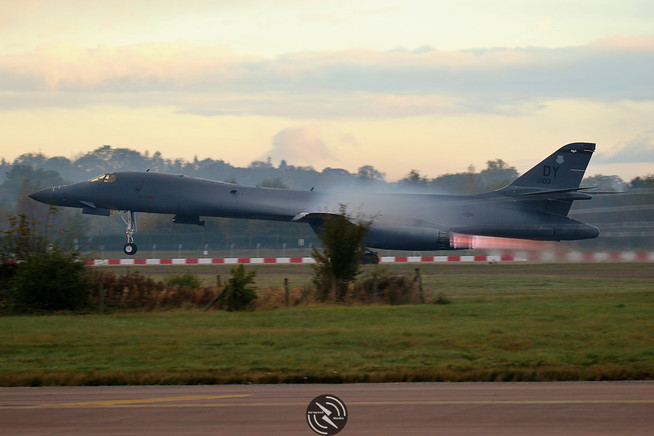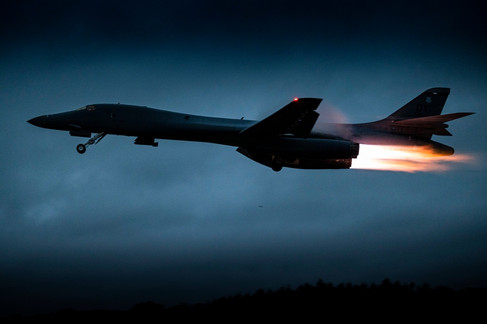Bones (B-1s) found in Gloucestershire
- Mike Lintott-Danks
- Feb 1, 2022
- 11 min read
During the late autumn the ground shook and the sky was filled with a deafening roar above the Gloucestershire town of Fairford and the surrounding villages as the 9th Bomb Squadron took to the air in their Rockwell B-1B Lancers. Four of these four engine variable geometry bomber were at the large RAF base for six weeks from the 6th October to the 16th November.
The B-1s or Bones arrived at RAF Fairford in two separate flights of two on 6th and the 7th October. They were greeted with a mass of photographers at the end of runway 27, as in recent years Bomber Task Force (BTF) deployments have consisted of Boeing B-52H Stratofortress’ or Northrop B-2A Spirits, these aircraft were guaranteed to attract a crowd. In the preceding days before their arrival support aircraft had been arriving from Dyess AB, Texas, to bring personnel and specific equipment, including spare engines, to RAF Fairford. These were transported by USAF Boeing C-17, Lockheed C-5M and a National Airlines 747.

The 9th Bomber Squadron is part of the 7th Bomb Wing and Air Force Global Strike Command based at Dyess AB, Texas. The 9th BS has had a distinguished history flying many of the US Air Forces iconic bomber aircraft including the Boeing B-17 Flying Fortress, B-29 Superfortress, B-36 Peacemaker, B-52 Stratofortress and General Dynamics FB-111.
Thanks to the British American Committee, Airspeed Media had the opportunity to attend a meet and greet evening on the 12th November with some of the air and ground crews from the 9th BS. This was a great opportunity to hear directly from the crews about the deployment and ask some questions regarding their mission and the Bone.
The 9th BS deploy as a whole squadron bringing all that they need for a Bomber Task Force deployment with them to RAF Fairford. Some of the deployed air crews had 4000hrs flying the Bone, including 2000 – 3000 combat hours, but some had recently transitioned to the aircraft and had 50hrs.
There was a presentation by Captain Steven ‘Pistol’ Carey, talking about the history of the 9th BS and the aircraft itself. The information below is from the US Air Force official page which was part of this presentation:- https://www.af.mil/About-Us/Fact-Sheets/Display/Article/104500/b-1b-lancer/
Mission Carrying the largest conventional payload of both guided and unguided weapons in the Air Force inventory, the multi-mission B-1 is the backbone of America's long-range bomber force. It can rapidly deliver massive quantities of precision and non-precision weapons against any adversary, anywhere in the world, at any time.
Features The B-1B's blended wing/body configuration, variable-geometry wings and turbofan afterburning engines, combine to provide long range, manoeuvrability and high speed while enhancing survivability. Forward wing settings are used for takeoff, landings, air refuelling and in some high-altitude weapons employment scenarios. Aft wing sweep settings - the main combat configuration -- are typically used during high subsonic and supersonic flight, enhancing the B-1B's manoeuvrability in the low- and high-altitude regimes. The B-1B's speed and superior handling characteristics allow it to seamlessly integrate in mixed force packages. These capabilities, when combined with its substantial payload, excellent radar targeting system, long loiter time and survivability, make the B-1B a key element of any joint/composite strike force.
The B-1 is a highly versatile, multi-mission weapon system. The B-1B's synthetic aperture radar is capable of tracking, targeting and engaging moving vehicles as well as self-targeting and terrain-following modes. In addition, an extremely accurate Global Positioning System-aided Inertial Navigation System enables aircrews to navigate without the aid of ground-based navigation aids as well as engage targets with a high level of precision. The addition of a fully integrated data link (FIDL) with Link-16 capability provides improved battlefield situation awareness and secure beyond line of sight reach back connectivity. In a time sensitive targeting environment, the aircrew can use targeting data received from the Combined Air Operations Centre or other command and control assets to strike emerging targets rapidly and efficiently.
The B-1B's onboard self-protection electronic jamming equipment, radar warning receiver (ALQ-161) and expendable countermeasures (chaff and flare) system and a towed decoy system (ALE-50) complements its low-radar cross-section to form an integrated, robust defence system that supports penetration of hostile airspace. The ALQ-161 electronic countermeasures system detects and identifies the full spectrum of adversary threat emitters then applies the appropriate jamming technique either automatically or through operator inputs.
Current modifications build on this foundation. Radar sustainability and capability upgrades will provide a more reliable system and may be upgraded in the future to include an ultra high-resolution capability and automatic target recognition. The addition of Link-16 and FIDL combined with associated cockpit upgrades will provide the crew with a much more flexible, integrated cockpit, and will allow the B-1 to operate in the fast-paced integrated battlefield of the future. Several obsolete and hard to maintain electronic systems are also being replaced to improve aircraft reliability.
Background The B-1A was initially developed in the 1970s as a replacement for the B-52. Four prototypes of this long-range, high speed (Mach 2.2) strategic bomber were developed and tested in the mid-1970s, but the program was cancelled in 1977 before going into production. Flight testing continued through 1981.
The B-1B is an improved variant initiated by the Reagan administration in 1981. Major changes included and additional structure to increase payload by 74,000 pounds, an improved radar and reduction of the radar cross section by an order of magnitude. The inlet was extensively modified as part of this RCS reduction, necessitating a reduction in maximum speed to Mach 1.2.
The first production B-1 flew in October 1984, and the first B-1B was delivered to Dyess Air Force Base, Texas, in June 1985. Initial operational capability was achieved on Oct. 1, 1986. The final B-1B was delivered May 2, 1988.
The United States eliminated the nuclear mission for the B-1 in 1994. Even though the Air Force expended no further funding to maintain nuclear capabilities, the B-1 was still considered a heavy bomber equipped for nuclear armament until 2007. The conversion to conventional only began in November 2007 under the original START treaty and was completed in March 2011 under the New START treaty. To make that conversion possible, two steps were taken:
During the first step a metal cylindrical sleeve was welded into the aft attachment point of each set of B-1 pylon attachments. This prevented installing B-1 Air Launched Cruise Missile pylons.
During the second step two nuclear armament-unique cable connectors in each of the B-1 weapons bays were removed. This prevented the pre-arm signal from reaching the weapons.
The B-1B holds almost 50 world records for speed, payload, range, and time of climb in its class. The National Aeronautic Association recognized the B-1B for completing one of the 10 most memorable record flights for 1994. The most recent records were made official in 2004.
The B-1B was first used in combat in support of operations against Iraq during Operation Desert Fox in December 1998. In 1999, six B-1s were used in Operation Allied Force, delivering more than 20 percent of the total ordnance while flying less than 2 percent of the combat sorties.
During the first six months of Operation Enduring Freedom, eight B-1s dropped nearly 40 percent of the total tonnage delivered by coalition air forces. This included nearly 3,900 JDAMs, or 67 percent of the total. In Operation Iraqi Freedom, the aircraft flew less than 1 percent of the combat missions while delivering 43 percent of the JDAMs used. The B-1 continues to be deployed today, flying missions daily in support of continuing operations.
General Characteristics Primary Function: Long-range, multi-role, heavy bomber Contractor: Boeing, North America (formerly Rockwell International, North American Aircraft); Offensive avionics, Boeing Military Airplane; Defensive Avionics, EDO Corporation Power plant: Four General Electric F101-GE-102 turbofan engine with afterburner Thrust: 30,000-plus pounds with afterburner, per engine Wingspan: 137 feet (41.8 meters) extended forward, 79 feet (24.1 meters) swept aft Length: 146 feet (44.5 meters) Height: 34 feet (10.4 meters) Weight: approximately 190,000 pounds (86,183 kilograms) Maximum Takeoff Weight: 477,000 pounds (216,634 kilograms) Fuel Capacity: 265,274 pounds (120,326 kilograms) Payload: 75,000 pounds (34,019 kilograms) Speed: 900-plus mph (Mach 1.2 at sea level) Range: Intercontinental Ceiling: More than 30,000 feet (9,144 meters) Armament: 84 500-pound Mk-82 or 24 2,000-pound Mk-84 general purpose bombs; up to 84 500-pound Mk-62 or 8 2,000-pound Mk-65 Quick Strike naval mines; 30 cluster munitions (CBU-87, -89, -97) or 30 Wind-Corrected Munitions Dispensers (CBU-103, -104, -105); up to 24 2,000-pound GBU-31 or 15 500-pound GBU-38 Joint Direct Attack Munitions; up to 24 AGM-158A Joint Air-to-Surface Standoff Missiles; 15 GBU-54 Laser Joint Direct Attack Munitions Crew: Four (aircraft commander, co-pilot, and two combat systems officers) Unit Cost: $317 million Initial operating capability: October 1986 Inventory: Active force, 62 (test, 2); ANG, 0; Reserve, 0
The weapons, as mentioned above, are carried in three separate bays and each bay can carry a different weapon or the bay can be fitted out with an additional fuel tank which is capable of carrying an extra 20,000lbs of fuel.
With the large array of weapons the Bone can carry, as described above, there are some impressive statistics at how quickly these can be delivered onto the target. If all three bays were carrying the maximum number of 84 Mk82 bombs these can be released form the aircraft in 1.5 seconds. A single bay on an 8-carry rack of 2000lb dumb or smart bombs, including JDAM and JASSM, can be released in 58 seconds delivering precision strikes on eight different targets.
The Bones ability to be able to deliver these weapons quickly allows for a 5 of dice pattern to be created on the ground if the targets position is unknown with each weapon hitting the ground simultaneously.

Pistol spoke about the Bomber Task Force mission: -
“Our current operations in the BTF construct is to be as agile as possible, basically taking an entire squadron and support staff, going somewhere, and deploying in the short term, assuring our allies and NATO partners and deterring Russia or anybody else who is trying to mingle in the AOR. We get a lot of good training out here learning how our NATO partners fight, and they learn how we fight so when we are doing it in the real world we have had this common experience and we know how to operate in the future.” Captain Steven ‘Pistol’ Carey
The aircraft wouldn’t be able to keep flying if it wasn’t for the support personnel. With the whole squadron deployed, including the maintenance staff and the weather shop which provide details of the weather not just over the airfield but at the intended target and the air-to-air refuelling (AAR) tracks. There is also the resource shop which tracks the air crew’s currency and whether they are legal to fly, fit to fly and they also track the crews’ hours to ensure that they have sufficient rest periods between missions. This includes the time it takes to change from day flying to night flying allowing the crews sufficient time to adapt their sleep patterns. The intelligence section of the Squadron is essential, informing the crews of the latest information on the target and enemy movements ensuring they have the most up to date target data.

There was an opportunity to ask some questions after the 9th BS had delivered their presentation. Some of these questions are below with the answers given by the 9th BS personnel.
How long does it take to drop and engine?
A highly proficient team in theatre an engine can be changed in 4hrs but this will take longer with inexperienced maintainers.
Do you have an opportunity to move about in long missions?
There is an opportunity to move around but the aircraft is really only made for two things fuel and bombs. If leaving the cockpit the ejection seat pins are put in and then there is an area between the two Weapon System Officers to stand up. If you use the toilet on board you can touch all three other crew.
How do you prepare for long flights or night flying?
The recent 18hr mission to Djbouti, that departed on the 10th November and returning on the 11th, where the Bones were integrating with partner nations, which included 4 AARs, the crews began preparing for this mission 5 – 6 days before allowing them to get their sleep patterns correct.
What is the usual flying at Dyess?
The training flights back in Texas are usually a 3hr flight, with crews flying once or twice a week. This allows time to mission plan – fly – debrief – desk job for a day.
BTF missions here at Fairford are, plan for 2–3 days then execute and then those crews will switch to pre-flight, which is to start the jets for the mission crews allowing them the greatest amount of time in the planning phase, and then the cycle starts again.
Missions flown during the BTF
During the BTF deployment the 9th BS flew multiple missions from RAF Fairford through the day and night with some aircraft returning from a day mission to then hot-pit and complete another mission into the late evening. These aircraft also had a crew change showing the ability of the 9th BS ground crews to regenerate the aircraft quickly and efficiently.
Some of the missions flown are in brief below from press releases: -
11th October 2021 – ‘Two B-1B Lancer bombers, deployed in support of U.S. European Command’s Bomber Task Force 22-1 mission series, integrated with Allied Joint Terminal Attack Controllers over Lithuania today ahead of their hot pit refueling at Spangdahlem Air Base, Germany.’
‘Coalition JTACS from Lithuania and Air Force Special Operation Command’s 352nd Special Operations Wing at RAF Mildenhall, England, coordinated with the bomber aircrews and identified simulated ground targets. The mission focused on enhancing readiness and interoperability for the controllers responsible for coordinating airstrikes to support ground forces.’
Senior Airman Chancler Nardone
‘Spangdahlem’s 52nd Fighter Wing executed a hot pit refueling, employing the new Versatile Integrating Partner Equipment Refueling (VIPER) kit.The VIPER kit system, an Agile Combat Employment capability, enables the bombers’ ability to land and operate from austere airfields at any forward staging location.’ https://www.usafe.af.mil/News/Press-Releases/Article/2806523/bomber-task-force-europe-b-1s-execute-agile-combat-employment-over-baltic-region/
19th October – ‘Two B-1B Lancer aircraft from the 9th Expeditionary Bomb Squadron, currently deployed to RAF Fairford for Bomber Task Force Europe, executed a counter maritime mission in the Black Sea region today alongside European allies and partners.’
‘The extended length of the mission required air refueling support from RAF Mildenhall’s KC-135 Stratotankers and a Turkish Air Force KC-135. NATO air refueling increases the combined effectiveness of the alliance by extending the range and duration of the strategic bomber missions.’
‘The strategic bombers also integrated with Romanian, Polish, and Canadian fighters, supporting the NATO Air Policing mission over Romania, as they transited through the region and throughout the maritime targeting mission.’
Senior Airman Colin Hollowell
26th October - The 9th Expeditionary Bomb Squadron’s B-1B Lancers joined Allied aircraft in the Baltic Sea region this weekend to execute a freedom of maneuver training mission.
The B-1s were joined by Polish fighters, which enable a total force integration with U.S. Naval Forces Europe-Africa and Special Operations Command Europe. NATO and coalition operations in the Baltics deter aggression and enable stability along the major sea and air routes.
Additionally, Allied Joint Terminal Attack Controllers in Estonia coordinated air support with strategic bomber crews by identifying training targets. Bomber Task Force 22-1’s B-1s provide a speed, payload configuration, and maneuverability that allow for seamless integration with mixed force packages on land and in the sea.
2nd November – ‘Two B-1B Lancers from the 9th Expeditionary Bomb Squadron joined Norwegian Air Force F-35 Lightning II aircraft over the Arctic region, today, as part of a Bomber Task Force Europe 22-1 integration and deterrence mission.’
‘The bombers and fighters executed an Allied targeting mission controlled by Norwegian Joint Terminal Attack Controllers. The mission focused on 5th generation integration and interoperability between the coalitions’ most advanced fighter platform and the supersonic strategic bomber.’
“BTF missions optimize our integration with allies and partners while enhancing our coalition response to threats throughout the Arctic,” said Gen. Jeff Harrigian, U.S. Air Forces in Europe – Air Forces Africa commander.“ Combining fifth-generation assets with long-range strike capabilities strengthens our collective deterrence initiatives.”
Leveraging fifth generation assets and combining them with long-range strike capabilities amplifies our allied and partnered deterrence initiatives.”
10th November - B-52 Stratofortress aircraft from Minot Air Force Base’s 5th Bomb Wing join the 9th Expeditionary Bomb Squadron’s B-1B Lancers to support the Bomber Task Force Europe mission series, Nov. 10, during a targeting mission throughout the North Sea region.
Air Force Global Strike Command’s strategic bomber platforms were joined by Royal Air Force Eurofighter Typhoon FGR4 aircraft, RAF Lakenheath’s F-15D Eagles and F-15E Strike Eagles, and RAF Mildenhall’s KC-135 Stratotankers, combining a force capable of executing super and sub-sonic strike capabilities with a range of conventional and precision guided munitions.
“Our ability to strike air, land, and sea targets with a coalition fighting force goes unmatched,” said Gen. Jeff Harrigian, U.S. Air Forces in Europe – Air Forces Africa commander. “Combining unique bomber strike packages with ally and partner capabilities offered within the European theater builds brings a force, which can counter any threat to our collective safety and security.”

Senior Airman Koby I. Saunders
Thank you to the 9th BS and the British American Committee for the opportunity to meet with some of the 9th BS personnel and special thank you goes to ‘Zoom’ who was able to arrange for us to climb aboard one of the Bones and sit in the cockpit and WSO seats. Let’s hope they come back again soon.
























































Comments